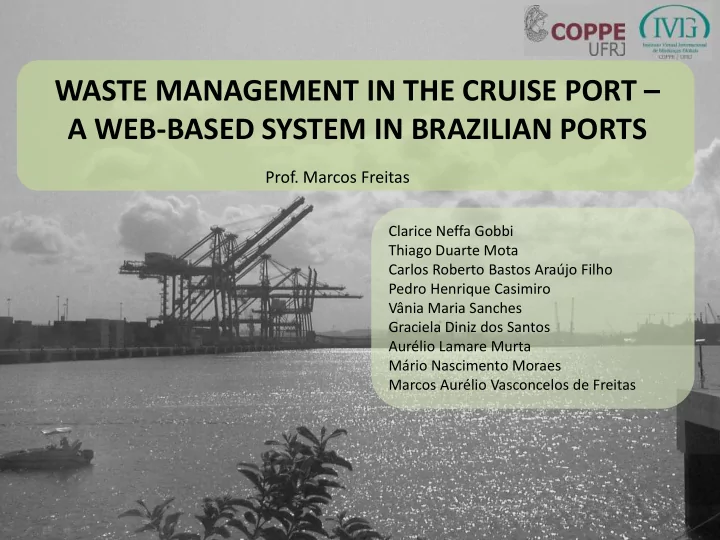

WASTE MANAGEMENT IN THE CRUISE PORT – A WEB-BASED SYSTEM IN BRAZILIAN PORTS Prof. Marcos Freitas Clarice Neffa Gobbi Thiago Duarte Mota Carlos Roberto Bastos Araújo Filho Pedro Henrique Casimiro Vânia Maria Sanches Graciela Diniz dos Santos Aurélio Lamare Murta Mário Nascimento Moraes Marcos Aurélio Vasconcelos de Freitas
INTRODUCTION Brazil is one of the countries in the world that features a set of propitious natural conditions for the development of marine tourism: Vast coastline along the Atlantic Ocean (with over seven thousand kilometers); Tropical climate; Diversity of natural resources. Favorable area for new investments.
INTRODUCTION Main Brazilian Cruise Ports Brazil: National coastal cruises and International cruises (Relatório Cruzeiros Marítimos: ABREMAR/FGV, 2011)
INTRODUCTION Number of cruises along the Brazilian coast by season (Relatório Cruzeiros Marítimos: CLIA ABREMAR BRASIL/FGV, 2014)
INTRODUCTION It is evident that the obstacle to the growth of this activity in Brazil is not the absence of demand, but rather the inadequate port infrastructure: The lack of physical space; The need for construction of new terminals and develop new destinations and new ports to receive the vessels; The issue of sustainability since it is not only the terminal that should be adequate to receive the ship, but the whole harbor area.
INTRODUCTION An important factor in the sustainability issue is the proper management of port waste. In Brazil, the Law N o 12.305/2010 established the National Policy on Solid Waste ( Política Nacional de Resíduos Sólidos - PNRS): Brings a set of principles, objectives, instruments and guidelines for an integrated solid waste management in the country Must be incorporated by all generators of solid waste, legal entity, public or private.
INTRODUCTION Research is needed to adequate the management of waste in ports with the legislation, since several waste management failures still occur in most Brazilian ports . The Compliance Program of Solid Waste and Liquid Effluent Management in Brazilian SeaPorts: Initiative of the Secretariat of Ports of the Presidency (SEP/PR) Implemented by the International Virtual Global Change Institute (IVIG/COPPE/UFRJ) Started in 2010
COMPLIANCE PROGRAM OF SOLID WASTE AND LIQUID EFFLUENT MANAGEMENT IN BRAZILIAN SEAPORTS Porto de Suape (PE) – Setembro de 2013
Objectives of the Program Compliance with the Law nº 12.305/2010 – PNRS no generation, reduction, reuse and processing, proper disposal/destination Development of environmental, economic and technological studies; Organization of a research network; Elaboration of a diagnosis/inventory of solid waste, liquid effluents and harmful synanthropic fauna; Systemization of the informations; Implantation of the management model.
Scope of the Program Solid Waste Liquid Effluents Sanitary effluent Industrial\oily effluent Rainwater drainage Harmful Synanthropic Fauna Rats Cockroaches Pigeons Mosquitoes
Scope of the Program: 22 ports
Among the obstacles found by the Program, the most relevant were the practices related to the control and generation of the information regarding waste management issues. Little information was available for access and fewer can be found in databases. In many cases the information is not recorded in any database, or even studied, in order to manage and publish an evaluation of a port. This scenario is seriously harmful to the management of waste, since the control and the generation of information is fundamental to know the profile of waste in a port and thus, to be possible to elaborate solutions and decision-making relating to an efficient waste management.
OBJECTIVE OF THIS WORK Provide a tool and a database to allow the management and control of solid waste and effluent generated in port areas, as well as harmful synanthropic fauna. The system aims to enable an automatically control that can be held with any device instead the use of paper filed records. The data regarding waste management of the Brazilian port areas could be recorded in a standardized manner into a single shared database.
METHODOLOGY Registration protocol was set for data collection at Brazilian ports. Protocols and data were collected by the professionals of the project. All information was digitally recorded in the documentation and gave rise to the tables and relationships of the system for application in data collection. The protocols were separated by large areas: "Solid Waste", "Fauna" and "Effluent” .
METHODOLOGY System was generated by programming language C # dot net (Asp net), with Ajax and made available in Hyper Text Markup Language (HTML) format. All access can be done by any device that has access to the internet with a web browser.
METHODOLOGY DIAGRAM OF ENTITIES AND RELATIONSHIPS OF THE SYSTEM
Field Activities
Field Activities
Field Activities ACCESO AGUA ALIMENTOS ABRIGO
Data Collection Field diagnosis Database Relational Multidimensional ETL database database
RESULTS Data collected included and stored in the database can be accessed (http://sistema.ivig.coppe.ufrj.br/sep/Login.aspx), and the user must enter username and password System login screen
RESULTS: Informatized System Geographic location of the ports – Port of Rio de Janeiro e Port of Santos
RESULTS: Informatized System Parameters for effluents
RESULTS: Informatized System Parameters for synanthropic fauna
RESULTS: Informatized System Parameters for solid waste
RESULTS: Informatized System General system overview – Data of each port: Solid Waste
RESULTS General system overview – Graphic Reports: Solid Waste
Manual of Best Practices for Port Operations
Manuals of Best Practices for each Port specifically
Integrated Management Plan of Waste, Effluent and Fauna Procedures Infrastructure Control and Technologies management plans
Thank you Obrigada! vaniasanches@gmail.com
Recommend
More recommend